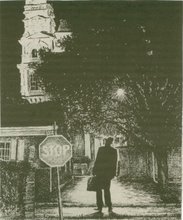
One day Andy came running into the office on
“I’ve just met the most amazing painter,” he enthused. “He’s Yugoslavian and he doesn’t paint like anybody else on
It was important to us that this prospective subject for our weekly interview spot didn’t paint like anybody else in town because that summer we had begun to review the shows at local galleries and art associations and we’d had our fill of schooners under full sail, fishing vessels making into port trailed by seagulls, flower arrangements and pet dogs. We were both yearning to experience what we called “real art.” Neither of us understood exactly what constituted this vital new art we hoped to discover for ourselves, but I realized there had to be something beyond the faux Impressionist autumn landscapes that hung at the North Shore Art Association, in
Having completed his interview, Andy rushed back into the office in the late afternoon and started typing away at his article on one of the paper’s old Royal manual typewriters, while Charlie Lowe, the in-house photographer and dark room technician, developed and printed Andy’s negatives (we used the old Graflex 4 X 5 Speed Graphic cameras then). When the eight by ten glossies came out of the darkroom I was astounded. There was Albert sitting behind an easel, working on one of his big, abstract cityscapes. This had to be the real thing, we both felt. The painting was not of a fishing boat, though Albert taught his students during those seven summers he and Vera spent in
Andy finished his article. I headlined it “Albert Alcalay’s America Shown in Color and Design,” and when it appeared in the Friday July 6th edition of the paper it revealed this unbelievably articulate painter, who not only talked about his own art, but about the art of being an artist: “I am not an artist only when I am working, but all the time,” Albert told Andy.
“You’ve got to meet Albert,” Andy said. Not “Mr. Alcalay,” Andy insisted, because he liked to be called by his first name.
The next day we both turned up at Albert’s house, the Rambler Cottage at
In visit after visit we talked about art, about writing, about life in
“This is a very European town,” Albert insisted as we roamed the Fort, the heart of Gloucester’s Sicilian community, or climbed Portuguese Hill on one side of Gloucester and Beacon Hill on the other, affording spectacular views of 17th, 18th and 19th century houses all seeming to tumble down the hills toward the waterfront; church steeples rising among them. For the first time, and with Albert’s help, Albert’s eye, I began truly to look at and to appreciate the place of my birth.
Some of what we saw began to appear in Albert’s work, abstracted in ways that helped me to understand what contemporary painters were after, not just the objects themselves but essences, shapes in space, spatiality itself; rhythms, motion. And Albert was tireless in explaining what it all meant, always with references to the work of other artists and books about art that became seminal for my own understanding of the aesthetic impulse.
But there was more. When I shared with Albert and Vera that I was going to begin the study of Italian after I returned to college in September, they suddenly began speaking the very language that had intrigued me for years. For the following three summers Albert and Vera, who were joined in 1959 by their friend Emiliano Sorrini, the graphic artist and print maker from Urbino, helped me to grasp the living language, just as Albert had opened my eyes to the entire world of avant-garde art and writing.
Finally, it was in Albert and Vera’s house, during the summer of 1959, on the eve of my departure for graduate studies in
(These remarks were delivered at a service in thanksgiving for the life of Albert Alcalay, on Sunday, May 16, 2010, at Memorial Church, Harvard University.)

